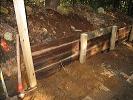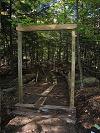
Started building retaining walls
October 10, 2006
It's been a couple years (!) since I last worked on the big cut (been busy with other projects
like having twins and building a new garage). I've also been collecting materials - retaining walls for a 200 foot long,
5 foot deep cut require a LOT of pressure-treated wood, and there's no way I'm gonna buy it. Fortunately, a friend
who owns a construction company got a contract to replace 16 decks at a local condo complex, and each deck is a couple
hundred square feet of 1x6 PT decking... EXACTLY what I need. So he tears it up and I bring it home, pull the nails out,
and I'm all set! The only thing I had to buy are the posts, which I found at Home Depot for a few bucks each.
The first order of business was to clean up the area that I had previously excavated. After 2 years the sides of the cut
had eroded and I need a flat bottom for the track. I also need to make sure that the bottom of the cut is at least 5 feet
wide for setting the posts, and roughly graded to about a 1% rise. To do all that I need a small excavator, so I rented a
Bobcat 331 from a place that's both closer and less expensive than the place from which I had previously rented the Kubotas.
And I found out why it was cheaper: The left track fell off twice and the hydraulics were all loose. So next time I'll pay
a bit more for a well-maintained Kubota.
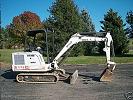
Here's a slideshow of my recent progress:
At the top of the cut was a large pool of water. When I dug into it, the entire trench was awash, then after being churned
up by the excavator the "floor" turned into quicksand (a thick mix of sand and mud) that was up to 12" deep in places. So in order to be
able to walk the trench to build the walls, I made a temporary walkway out of 2x12s. It looks like something straight out of WW1.
Fortunately, after a day or two, most of the mud dried into a hard, solid base. But in the last 2 slides you can see that the mud is still
pretty wet. There's a lot of groundwater seeping out of the hillside, so this area will stay pretty wet until I install the retaining walls.
Compare the above slideshow with this one from when I originally dug the cut over 3 years ago.
The tall thing in the first slide above will be a "telltale". In the days before locomotive-controlled airbrakes, a train's brakeman had to
manually set each car's brakes by turning a brakewheel located at the end of each car's roof. To set & relelase these the brakeman would
run the length of the moving train, jumping from roof (OSHA would not have approved!). In order to keep the brakeman from getting
killed when the train went under a low overpass or into a tunnel, the railroad erected a structure that spanned the track and had thick,
knotted ropes dangling from it, so instead of getting killed by the tunnel the brakeman would get knocked down (and hopefully not off
the train) by the ropes.
A modern version of this would be the piece of pipe hanging over the entrance to a parking structure... if your tall SUV's roof bumps that,
you probably shouldn't enter the garage.
Because the cut will have a 5' high tunnel in the middle, I want to know if the train (and most importantly, passengers' heads) will clear
the tunnel, I made my own telltale. That, and it looks kinda cool :)
This underside view of my telltale shows where I'll hang the ropes:
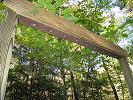
Fortunately I'm able to drive my truck right up to where I'm working.
This makes it a lot easier to bring in the wood, plus the tailgate makes a good workbench:
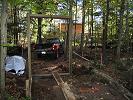
Off in the distance at center-right you can see the (black) deck truss bridge. The end of the bridge
and the telltale's sill are at the same elevation, but the ground in between (where the truck
is parked) is up to 24" lower. Originally I was going to make a raised fill (about 3 feet wide)
in this area, but hauling all that dirt will be a lot of work. So I'm now thinking of crossing
it with a low trestle given that I now have tons of (free) used pressure-treated lumber.
Here's a closeup of the retaining walls:
